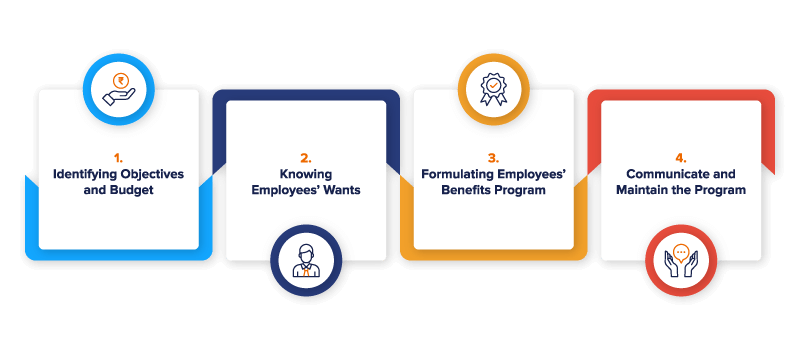Employee’s Compensation and Benefits in India

Table of Contents
India is one of the fastest growing economies in the world and has a diverse and promising talent pool. The number of companies and industries is increasing day by day, and with the increase in this number, the competition among them is also increasing. So, to stay on top of their competitors, it has become important for companies to compensate their employees adequately and provide them additional benefits to keep them satisfied and focused on the company’s goal.
Employee compensation and benefits are the components of employees payroll for any organization. But there are laws for both the employee compensation and the benefits. They include laws for paying minimum wages, paying on time as well as securing employees financially by providing basic benefits. There are other laws too, but they aren’t as much focused on the employees as the compensation and benefits laws.
Compensating employees could be time consuming, especially when you have to comply with different kinds of statutory laws, but an payroll automated software fully complied with all the statutory laws could help you calculate and compensate your employees with ease. By reading this article, you will get to know about how employees are paid in India according to their labor laws and how you can plan your employees’ benefits program.

What is Employee Compensation?
In layman’s terms we can say that employee compensation is the amount of money paid to employees or workers for their work done for the organization. Compensation is paid to the employees on the basis of different parameters, such as their work duration and their performance. But one thing that is common among every organization for paying compensation is complying with the compensation laws of India.
When the employees are compensated handsomely, they feel motivated towards doing their work, they feel satisfied and their productivity also increases. As long as they are feeling valued by the organization, employees won’t consider leaving their organization resulting in an increasing organization’s retention rate.
Types of Compensation
There are two main kinds of compensation, direct compensation and indirect compensation, they both serve different purposes and both are decided upon different parameters. Let’s learn more about these types of compensation:
Direct Compensation
It is the basic salary or wages of the employee. It is decided while discussing terms during recruiting the employee. Employees’ performance doesn’t have any direct impact on their basic salary. But their performance comes into picture during their annual performance evaluation to decide the increase or decrease in their basic salary.
Indirect Compensation
Indirect compensation refers to the monetary incentives, commissions, bonuses, and overtime pay, paid to employees in addition to their basic salary. It is decided on the basis of their performance and predetermined targets.

What are Employees Benefits?
Employee benefits are indirect pay provided by the organization to employees in addition to their base wages or salaries. The common benefits cover the basic needs of the employees like medical insurance and life insurance, while other benefits like paid vacations, performance bonus, and retirement plans can be used by organizations as a tool to motivate their employees, which also results in an increase in employee retention rate and performance. Employee benefits can also be used to attract a mass number of talented candidates while hiring for a vacancy.
The major difference between compensation and benefits is that compensation refers to direct monetary incentives paid to employees for their work each month, while benefits are non-monetary incentives provided through various programs or schemes over a longer period. Check out top payroll management systems options that enable organizations to streamline the process of distributing compensation while effectively tracking and administering employee benefits. These systems also help ensure compliance with statutory regulations and foster a more efficient, transparent approach to overall rewards management.
How to Design Employees’ Benefits Program in India?
Employees’ benefits program is a set of employee benefits an organization provides to their employees. It is a program which represents an organization’s behaviour towards their employees, as it shows how and what the organization is spending on their employees. That is why it’s important to have a decent employee’s benefits program to keep the employees satisfied. The following points are the steps to design an ideal employees’ benefits program:

Identifying Objectives and Budget
Before creating any plans for employees’ benefits, you should know why you are planning for it, what purpose it will serve or if you really need it. Generally, the main objective of this plan is to keep your employees satisfied and motivated. One way to ensure that your benefits plan is sufficient enough for your employee is by making your plan after comparing different competitors plans to make sure that your employees benefits plan is better than your competitors plan. After identifying the objective of your employee benefits program, you should set a budget for spending on benefits.
Knowing Employees’ Wants
Employees’ benefits programs are all about keeping your employees’ satisfied, so taking their opinion about what they want in their employees benefits is extremely important. Afterall, it’s the employees whose CTC structure will get affected by it. An easy way to do that is by performing a common survey to know what your employees want.
Formulating Employees’ Benefits Program
After identifying your employees wants your can easily get an idea of what to include in the program and start formulating the program. Select the program which is financially viable as well as wanted by your employees. Try to provide optional benefits for employees so that they can select the benefits as per their convenience.
Communicate and Maintain the Program
After the benefits program is formulated, inform and provide your employee with that program and take their feedback about it to know for any improvements. After your program gets implemented and well running, start taking periodic evaluations to know the effectiveness of the program.

Conclusion
There are so many employee benefits for organization to choose from, considering this and designing your employees benefits plan according to it is challenging but we hope that through this you have learnt everything about compensation laws to compensate your employees and employees benefits to add in your employees CTC structure.
Grow your business with factoHR today
Focus on the significant decision-making tasks, transfer all your common repetitive HR tasks to factoHR and see the things falling into their place.

© 2025 Copyright factoHR


